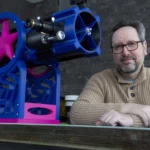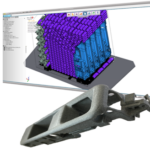Daniel Bomze, Director of Medical Solutions at Lithoz, discussed their novel Lithabone HA 480 material for 3D printed bone replacements in a recent interview with TCT Magazine. This bioabsorbable material, based on hydroxyapatite, enhances the design and functionality of bone graft substitutes. It offers higher wall thicknesses (1.6mm to 10mm), reduced overpolymerisation, and a significantly extended shelf life.
LithaBone HA 480 (pictured below) addresses the limitations of traditional bone implants, which cannot adapt to growing tissues, especially in children. This issue is critical in cases like hydrocephalus, where frequent surgical revisions are needed. The new material allows for the creation of complex, patient-specific geometries that were previously unattainable with subtractive manufacturing methods.

“You can now actually manufacture implants with 3D printing and generate those open, porous, interconnected networks which allow the ingrowth of the bulk of the blood vessels and the removal of metabolic products, which is important for the healing process,” said Bomze.
“There’s other ways to shave these materials, but only additive manufacturing allows you to create the geometry of the pore and the connection between the pore.”
User feedback from previous bone graft materials influenced the development of LithaBone HA 480. Improvements include overcoming challenges related to material stiffness, which limited design possibilities, and storage issues due to the need for deep-freezing during transportation.
Looking ahead, Bomze anticipates significant advancements from Lithoz’s clients in the application of this technology. These developments are expected to transform the perception and capabilities of ceramic 3D printing in medical applications, offering new solutions for patients and surgeons. The future of 3D printing in medicine, particularly with materials like Lithabone HA 480, suggests a paradigm shift in patient-specific treatments and surgical applications. Enhanced material properties and user-driven improvements signal a progressive trend towards more adaptable, efficient, and patient-friendly medical solutions.
Source: tctmagazine.com
Come and let us know your thoughts on our Facebook, X, and LinkedIn pages, and don’t forget to sign up for our weekly additive manufacturing newsletter to get all the latest stories delivered right to your inbox.









